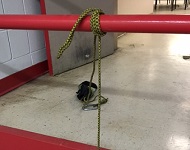
By David DeStefano
Firefighters assigned to both engine and truck companies will benefit from the many advantages of having a length of personal rope that they can quickly and safely deploy during operations. The hardware is simple, inexpensive, and may be carried for rapid deployment under a variety of circumstances, some of which I will detail in this article.
Primary Applications and Deployment
You can use a personal rope to support a wide variety of operations. The primary scenario in which the rope is often deployed is to facilitate a search. You can accomplish this using numerous tactics. Members searching small areas such as bedrooms, small apartments, or offices may enter through an exterior door, a hallway, or a common corridor. Secure the rope to a substantial object at the point of entry or area of refuge. You can then pass a rope through a lower door hinge to use as an anchor. In wood frame construction, if other options are not available, you can punch a hole in a wall located in a safe area and secure the search rope around a stud. Another option involves driving a halligan tool into a wall or floor if its use for this purpose will not deprive members of entry/exit capabilities during the search. You can also make entry through a window or fire escape.
Firefighters can conduct a rapid vent-enter-search under very adverse conditions by controlling (closing) a door between the search room and the path of the fire. Secure the personal rope to the ladder to facilitate orientation back to the window. In either scenario, the members searching can maintain their orientation to an egress point, thereby increasing their confidence and speed during a search of a smaller room or area under severe conditions.
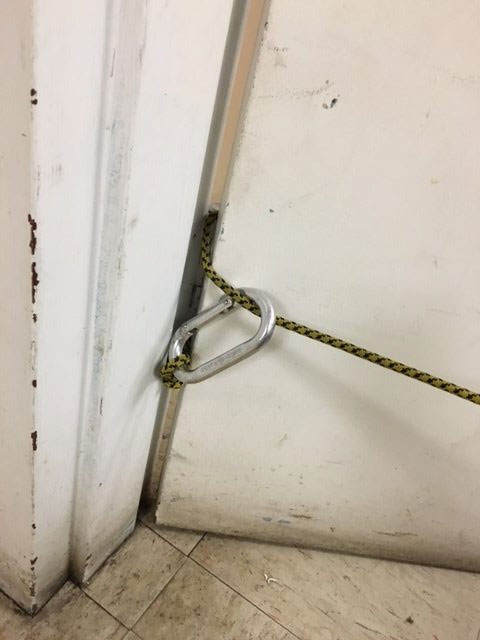
(1) You can anchor a search rope through the bottom hinge of a door to the room being searched. (Photos by author.)
When conducting these searches in Collyer’s Mansion (hoarding)–style conditions, any rope configuration may unusable and unsafe because of the content load and lack of navigable space. However, you can employ a technique to improve the feasibility of a rope-oriented search. In this scenario, a firefighter will remain at the window or door to provide orientation. This member should use the D-handle end of a hook to run the search rope through as the hook is held upright, keeping the rope in the air (off the debris) for at least some distance into the room being searched. Although this method is far from perfect, it offers some potential to use a personal rope to conduct at least a partial search under cluttered conditions.
You can also use the search rope to identify the location of a victim in instances where rescue isn’t an immediate option. A victim may require extrication from debris or rescue from a hole in the floor or stairs. The initial search team may need to withdraw without completing a recue if this scenario occurs near the end of their safe air supply. Securing the rope to a nearby object or directly to the victim will save a fresh rescue team valuable time in finding the victim and still facilitate the egress of the original search team.
RELATED: Capo on Search Ropes: Exiting the Structure ‖ Sitz on the Personal Rope ‖ Dorgan on Search Rope Basics
Firefighters equipped with a personal rope may also deploy it in conjunction with a mainline search rope during a large open area search or an aisle search in retail or warehouse occupancies. You can attach the rope to the main search line at designated intervals by a metal ring or a butterfly knot attached to the main rope. This configuration allows added capability in large area searches and provides a path back to the main line and egress point. The company officer deploys and monitors the main search rope, who then controls the overall deployment.

(2) By running the search rope through a D handle hook and maintaining a firefighter at a door or window for orientation, the search rope may be more effective in hoarder occupancies.
The System
Firefighters should carry enough rope to conduct primary searches of the smaller rooms, offices, and other spaces they will encounter in their response area. Generally, these applications lend themselves to using between 25 and 35 feet of rope. In determining the total length of rope they will carry, firefighters should consider that deploying too much rope may cause confusion and entanglement. However, you must also factor in the amount of rope used to secure an anchor point and enter the search area.
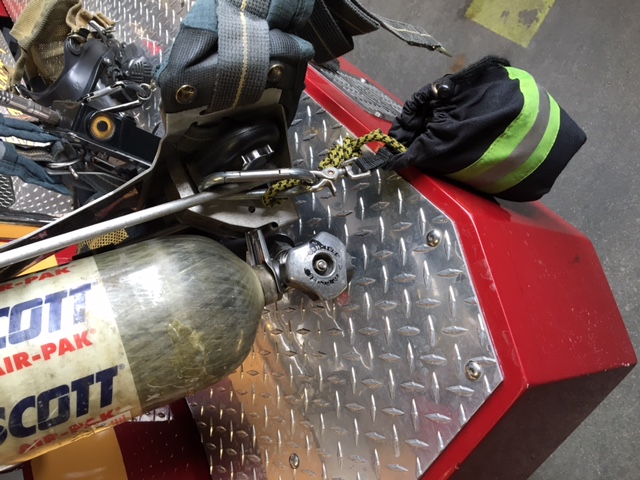
(3) Secure the personal rope bag to the SCBA in such a way that it will not become unfastened accidentally.
Store and carry search rope for rapid deployment under adverse conditions. Accomplish this by using a small rope bag that you can attach to yourself. The rope bag must be accessible yet not able to be easily torn off or unintentionally separated from the firefighter. The system may be fastened to a secure point on the members’ self-contained breathing apparatus using a carabiner. Unlike rope systems used for other applications, nonlocking carabiners or those easily unlocked with a single gloved hand are preferred for search rope evolutions. Using a large carabiner on the anchor side and the attachment side of the rope will help ensure rapid deployment and removal, if necessary. The anchor point and the point of attachment to the firefighter are the keys to the lifeline back to safety.
As with any system, the personal rope can only help if a firefighter has it on his person and feels confident using the rope. Members who have a rope bag on the rig and fail to attach it to their air pack will never be able to deploy this device in time of need. Likewise, those who carry the system without regular training will likely not deploy the search rope under stressful conditions.
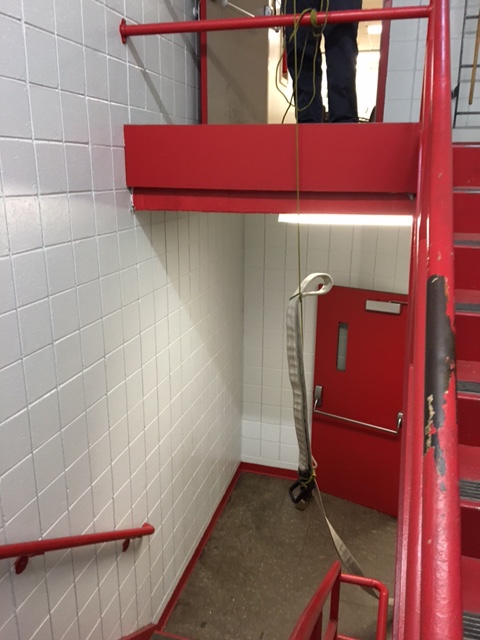
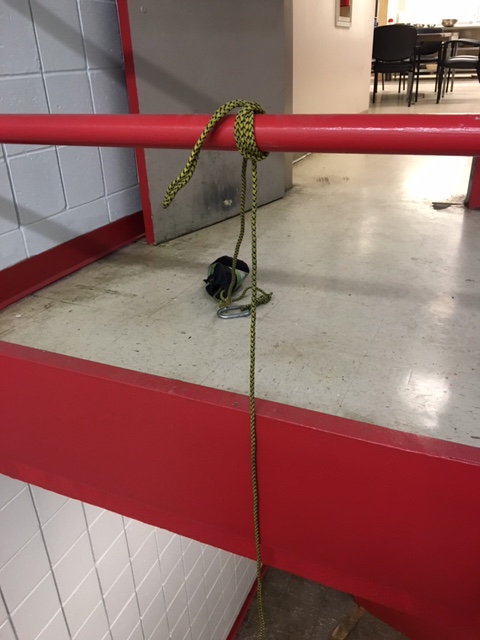
(4, 5) You can also use the personal rope for many utility purposes, including hauling a hoseline to an upper floor.
Secondary Applications
Like many fire service tools, the personal rope has multiple applications beyond its primary use. Members may find that they use the personal rope for some of these other duties more frequently than its deployment for search and rescue operations.
With its convenience and ease of deployment out a window or down a stair shaft, the personal rope often finds use as a means to hoist equipment or hose to an upper floor. Many departments commonly perform outside stretches from a window or balcony to a second or third floor in a private dwelling or multidwelling without a standpipe. The personal rope facilitates this tactic without needing to bring an extra rope bag. Two members may link their ropes with a knot or carabiner to increase the working length.
While performing ventilation, firefighters assigned to the roof or floor above the fire may need to take out a window. You can tie a halligan tool to the rope (or clip a link on the tool with a carabiner) the distance to the target window is measured with the rope and then held with the firefighter’s hand. Next, swing the tool into the target window, taking advantage of the pendulum effect out the window or over the roof.
In addition, while other implements such as webbing or short pieces of rope may be preferred ways to control a door, you can first use the personal rope in this manner and then redeploy it to search the room or apartment. Forcible entry/search teams that practice this technique may find they can accomplish door control during forcible entry and then attach the same rope to the bottom door hinge to immediately begin a search.
There are certainly many more applications for a personal rope bag than what has been discussed here. Each company and individual firefighter should practice with deployment and potential applications as frequently as possible. A rope left on the gear rack or in the rig will never benefit anyone on the fireground. Train with the personal rope and carry it as part of your personal protective equipment on every run.
 David DeStefano is a 26-year veteran of the North Providence (RI) Fire Department, where he serves as captain of Ladder Co. 1. He was previously assigned as a Lieutenant in Ladder 1 and Engine 3 and a firefighter in Ladder 1. He has a master’s degree in public administration and a bachelor’s degree in fire science. He is an instructor/coordinator for the Rhode Island Fire Academy and teaches a variety of fire service topics throughout Southern New England. He can be reached at dmd2334@cox.net.
David DeStefano is a 26-year veteran of the North Providence (RI) Fire Department, where he serves as captain of Ladder Co. 1. He was previously assigned as a Lieutenant in Ladder 1 and Engine 3 and a firefighter in Ladder 1. He has a master’s degree in public administration and a bachelor’s degree in fire science. He is an instructor/coordinator for the Rhode Island Fire Academy and teaches a variety of fire service topics throughout Southern New England. He can be reached at dmd2334@cox.net.

